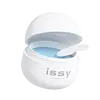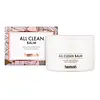What's inside
What's inside
 Key Ingredients
Key Ingredients

 Benefits
Benefits

 Concerns
Concerns

 Ingredients Side-by-side
Ingredients Side-by-side

Ethylhexyl Palmitate
EmollientButyrospermum Parkii Butter
Skin ConditioningPEG-20 Glyceryl Triisostearate
EmollientHydrogenated Palm Kernel Oil
EmollientCaprylic/Capric Triglyceride
MaskingTheobroma Cacao Seed Butter
EmollientSynthetic Wax
AbrasiveHelianthus Annuus Seed Oil
EmollientHydrogenated Sunflower Seed Oil
Skin ConditioningPhenoxyethanol
PreservativeLavandula Angustifolia Oil
MaskingEthylhexylglycerin
Skin ConditioningSqualane
EmollientRetinyl Palmitate
Skin ConditioningBisabolol
MaskingTocopherol
AntioxidantZingiber Officinale Root Extract
MaskingCI 61565
Cosmetic ColorantEthylhexyl Palmitate, Butyrospermum Parkii Butter, PEG-20 Glyceryl Triisostearate, Hydrogenated Palm Kernel Oil, Caprylic/Capric Triglyceride, Theobroma Cacao Seed Butter, Synthetic Wax, Helianthus Annuus Seed Oil, Hydrogenated Sunflower Seed Oil, Phenoxyethanol, Lavandula Angustifolia Oil, Ethylhexylglycerin, Squalane, Retinyl Palmitate, Bisabolol, Tocopherol, Zingiber Officinale Root Extract, CI 61565
Ethylhexyl Palmitate
EmollientCetyl Ethylhexanoate
EmollientPEG-20 Glyceryl Triisostearate
EmollientPolyethylene
AbrasivePEG-8 Isostearate
Emulsifying1,2-Hexanediol
Skin ConditioningButyrospermum Parkii Butter
Skin ConditioningTocopheryl Acetate
AntioxidantCitrus Aurantium Dulcis Peel Oil
MaskingLavandula Angustifolia Oil
MaskingPelargonium Graveolens Flower Oil
MaskingAmyris Balsamifera Bark Oil
MaskingEucalyptus Globulus Leaf Oil
PerfumingMelaleuca Alternifolia Leaf Oil
AntioxidantCitrus Paradisi Peel Oil
MaskingCitrus Aurantium Bergamia Fruit Oil
MaskingBoswellia Carterii Oil
MaskingJuniperus Mexicana Oil
MaskingWater
Skin ConditioningCocos Nucifera Fruit Extract
EmollientButylene Glycol
HumectantCitrus Aurantifolia Fruit Extract
Skin ConditioningCitric Acid
BufferingPhenoxyethanol
PreservativeNelumbium Speciosum Flower Extract
Skin ConditioningFreesia Refracta Extract
Skin ConditioningRose Extract
Skin ConditioningLeontopodium Alpinum Extract
Skin ConditioningJasminum Officinale Extract
MaskingNarcissus Pseudo-Narcissus Flower Extract
Skin ConditioningLilium Tigrinum Extract
Skin ConditioningIris Versicolor Extract
EmollientEthylhexylglycerin
Skin ConditioningLimonene
PerfumingCitral
PerfumingLinalool
PerfumingEthylhexyl Palmitate, Cetyl Ethylhexanoate, PEG-20 Glyceryl Triisostearate, Polyethylene, PEG-8 Isostearate, 1,2-Hexanediol, Butyrospermum Parkii Butter, Tocopheryl Acetate, Citrus Aurantium Dulcis Peel Oil, Lavandula Angustifolia Oil, Pelargonium Graveolens Flower Oil, Amyris Balsamifera Bark Oil, Eucalyptus Globulus Leaf Oil, Melaleuca Alternifolia Leaf Oil, Citrus Paradisi Peel Oil, Citrus Aurantium Bergamia Fruit Oil, Boswellia Carterii Oil, Juniperus Mexicana Oil, Water, Cocos Nucifera Fruit Extract, Butylene Glycol, Citrus Aurantifolia Fruit Extract, Citric Acid, Phenoxyethanol, Nelumbium Speciosum Flower Extract, Freesia Refracta Extract, Rose Extract, Leontopodium Alpinum Extract, Jasminum Officinale Extract, Narcissus Pseudo-Narcissus Flower Extract, Lilium Tigrinum Extract, Iris Versicolor Extract, Ethylhexylglycerin, Limonene, Citral, Linalool
 Reviews
Reviews

Ingredients Explained
These ingredients are found in both products.
Ingredients higher up in an ingredient list are typically present in a larger amount.
This ingredient is also known as shea butter. It is an effective skin hydrator and emollient.
Emollients help soothe and soften your skin. It does this by creating a protective film on your skin. This barrier helps trap moisture and keeps your skin hydrated. Emollients may be effective at treating dry or itchy skin.
Shea butter is rich in antioxidants. Antioxidants help fight free-radicals, or molecules that may harm the body. It is also full of fatty acids including stearic acid and linoleic acid. These acids help replenish the skin and keep skin moisturized.
While Shea Butter has an SPF rating of about 3-4, it is not a sunscreen replacement.
Shea butter may not be fungal acne safe. We recommend speaking with a professional if you have any concerns.
Learn more about Butyrospermum Parkii ButterEthylhexyl Palmitate, also known as octyl palmitate, is created from 2-ethylhexyl alcohol and palmitic acid. It is a fatty acid ester.
The fatty acid content of Ethylhexyl Palmitate makes it an emollient. Emollients help soften and hydrate your skin by trapping moisture within.
Ethylhexyl Palmitate is also used to help improve the texture of cosmetics. It helps other ingredient dissolve in products and help disperse ingredients more evenly.
You'll likely find this ingredient in sunscreen, as it is often used to mix UV-blocking ingredients such as avobenzone and ethylhexyl triazone.
It can also help stabilize the fragrances in a product as a fragrance fixative.
Ethylhexyl Palmitate can be used to substitute mineral oil.
Due to its high fatty acid content, it may not be fungal-acne safe.
Learn more about Ethylhexyl PalmitateEthylhexylglycerin (we can't pronounce this either) is commonly used as a preservative and skin softener. It is derived from glyceryl.
You might see Ethylhexylglycerin often paired with other preservatives such as phenoxyethanol. Ethylhexylglycerin has been found to increase the effectiveness of these other preservatives.
Lavandula Angustifolia Oil is more commonly known as lavender essential oil. It is considered a fragrancing ingredient.
Lavender imparts a famous scent. While the smell is lovely, this ingredient and may sensitize skin in topical products. This is because about 85% of the oil is made up of linalool and linalyl acetate.
When exposed to air, these two compounds become strong allergens. This ingredient exhibits cytotoxicity at low concentrations; amounts of 0.25% have been shown to damage skin cells.
A study from Japan found this ingredient caused lavender sensitivity after widespread exposure.
Lavender essential oil has some antimicrobial, antibacterial, and anti-inflammatory properties. However, the cons of this ingredient may outweight the pros.
More research is needed to confirm lavender essential oil's effects when used in aromatherapy.
Lavandula Angustifolia is known as the English Lavender and famous for creating purple fields in Provence, France.
Learn more about Lavandula Angustifolia OilPeg-20 Glyceryl Triisostearate comes from Isostearic Acid and glycerin.
It is an emollient, emulsifier, and gentle cleanser. As an emollient, it helps trap moisture to keep skin soft and hydrated. Emulsifiers help prevent ingredients from separating.
This ingredient is common in oil-based products. This is because it helps oil-ingredients be easily washed away without leaving a residue.
Peg-20 Glyceryl Triisostearate may not be fungal-acne safe.
Learn more about PEG-20 Glyceryl TriisostearatePhenoxyethanol is a preservative that has germicide, antimicrobial, and aromatic properties. Studies show that phenoxyethanol can prevent microbial growth. By itself, it has a scent that is similar to that of a rose.
It's often used in formulations along with Caprylyl Glycol to preserve the shelf life of products.